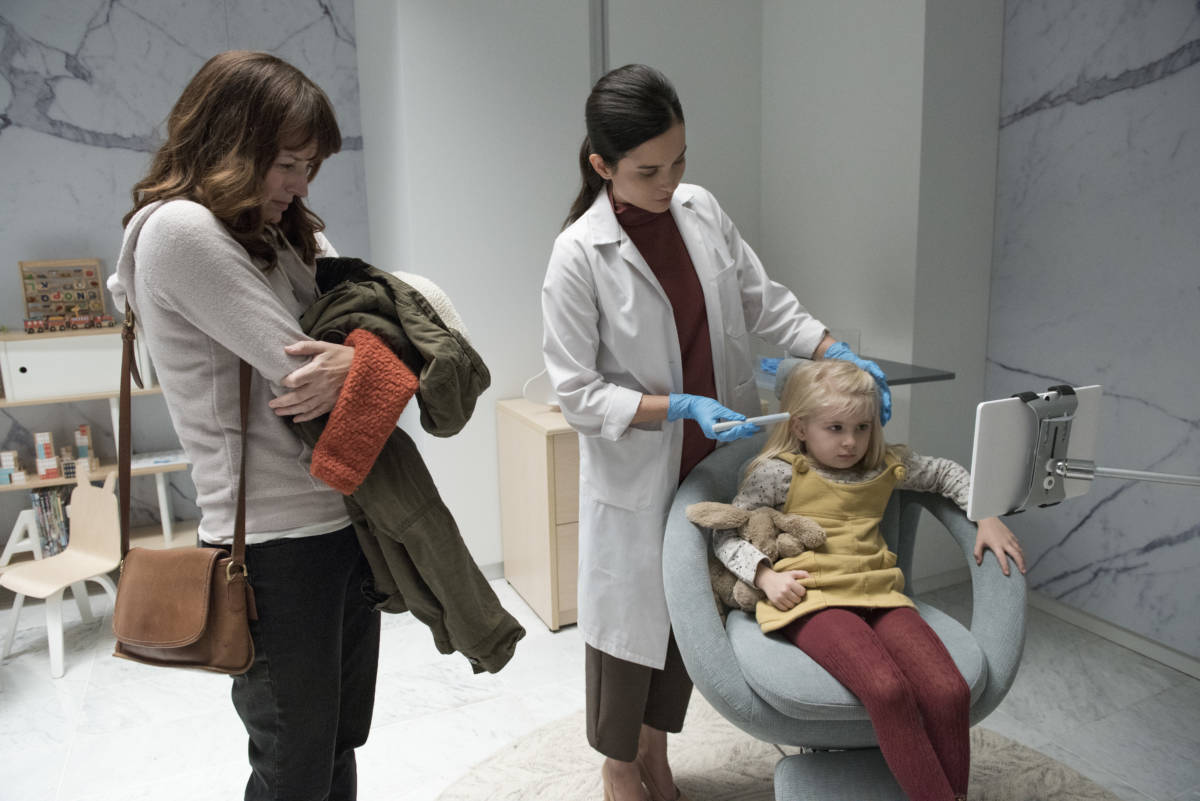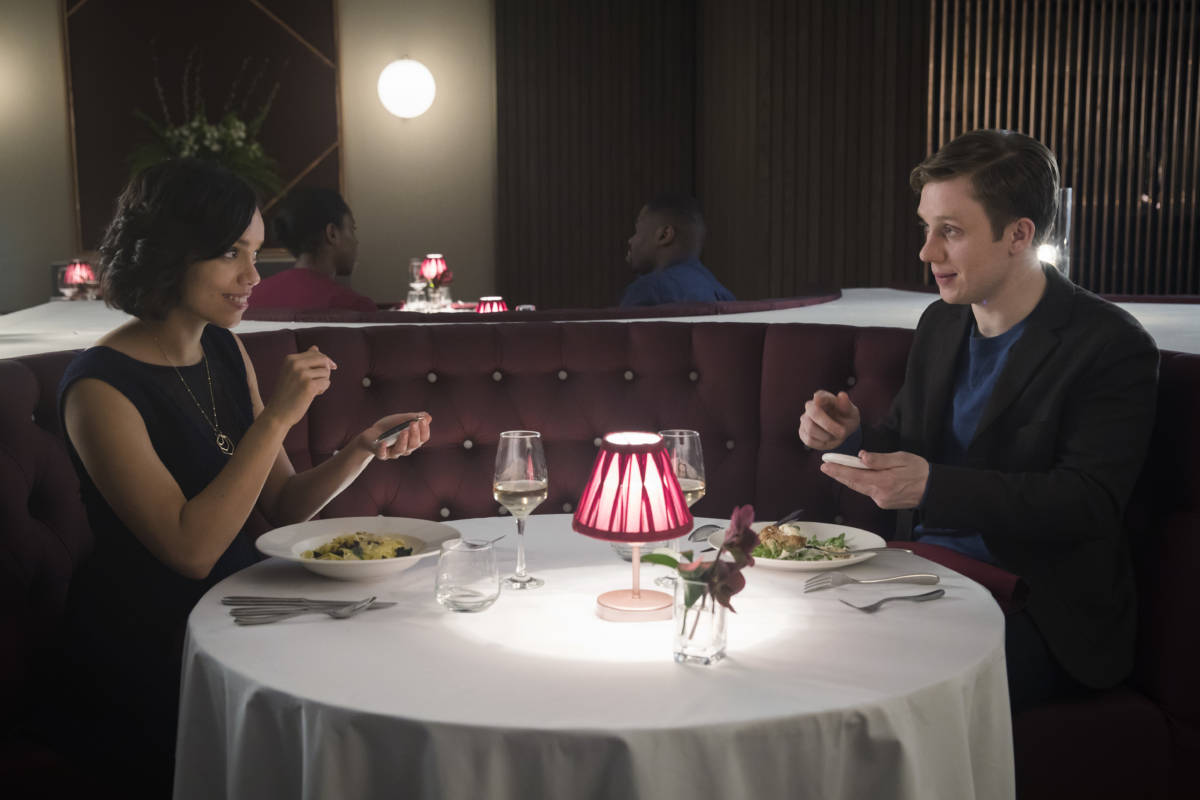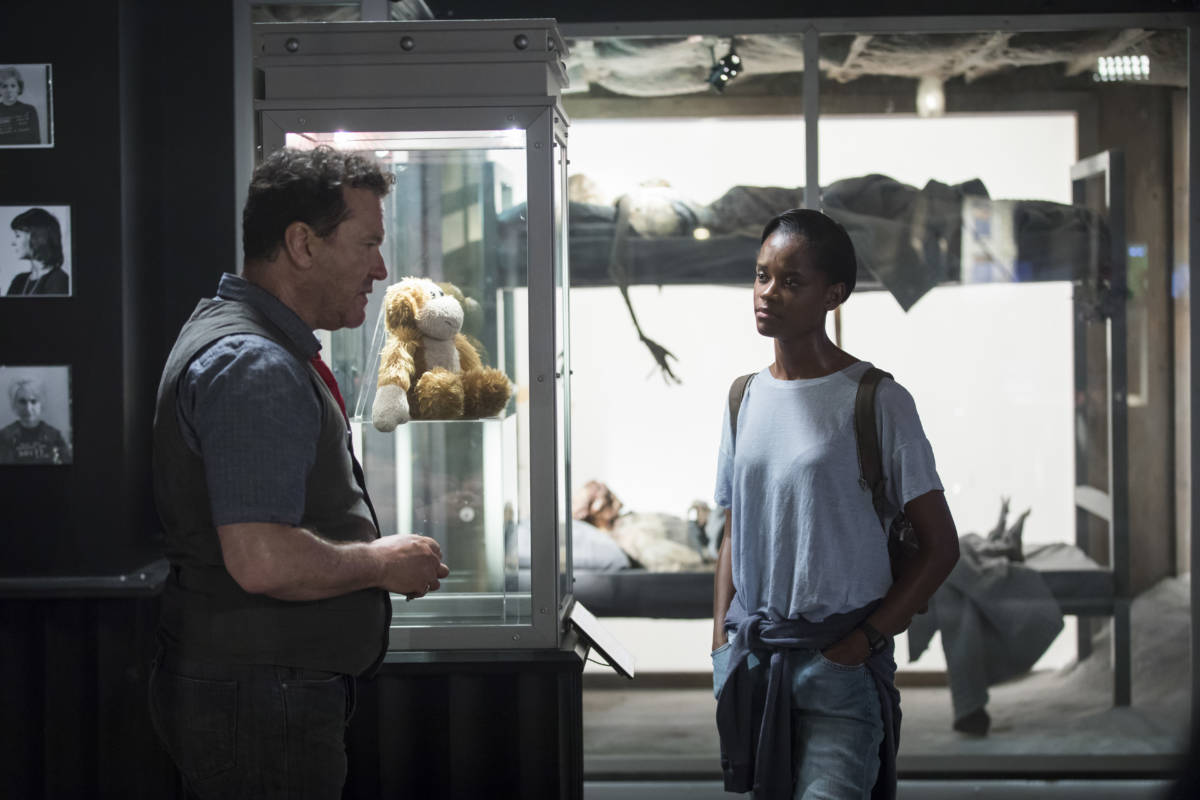After its long tenure of fully nineteen episodes, Charlie Brooker’s dark-tech anthology series Black Mirror is, with season 4, beginning to stoop under the weight of its own canon ever-so-slightly. This isn’t to say it’s retreading old ground in the narrative sense – however, this season is a first in that it reuses the dark-tech of previous episodes. This is particularly significant because, being an anthology series, the actual human characters tend to be somewhat secondary, it’s the dark-tech that’s the true protagonist, it’s certainly what the audience is here to see at any rate.
Even this is not out-and-out criticism. Most of the fictional technologies Black Mirror depicts have been strong enough concepts that they can provide a basis for at least a couple of stories. Indeed, a couple of them have been supercharged versions of modern-day social media, and there’s enough wacky stories coming out of that as it is. Similarly, this season is heavier on references to previous episodes than it has been before, but with more episodes to draw on, that’s what you’d expect – plus, it’s blink-and-you-miss-it, Easter eggy stuff, that doesn’t have to detract from the narrative unless you decide to draw up a conspiracy theory flowchart to illustrate exactly how all the episodes can fit into a coherent continuity.

But, sad to say, it does feel like the returns are diminishing, especially since Netflix took over and insisted on taking more bites from this particular apple. It’s still good, and all marvellously constructed, but it’s not like the first two seasons where every episode was must-see and profoundly disquieting. There’s also less of a focus on social media, which is particularly disappointing given Brooker’s mission statement, which is – despite how clearly terrifying the technology is – that the technology is neither good nor bad, it simply unleashes people to act in funky-fresh good and bad ways. This is not dissimilar from zombie master George A. Romero’s underlying philosophy in his Dead film series, where the zombies are more of a natural disaster and at bottom, the narrative turns on the same kinds of social conflict we have anyway without zombies.
(It’s probably no coincidence Brooker had a go at writing a Dawn of the Dead fanfiction set in the Big Brother house, in his TV miniseries Dead Set.)
A really solid Black Mirror season breakdown would involve – as you run through the episodes from worst to best – some sort of increasingly terrifying revelation about your own life with each episode, and as you reached the top three, it would start to cause you physical pain. Come the final one, you’d want to take a long shower if you didn’t know exactly what atrocities the big shower companies – and, by proxy, you – are responsible for. But to my disgust, the world government formally vetoed my plan to inject this review directly into your cerebral cortex, or otherwise do something awful involving lasers, so I have to use my words instead.
So here it is – the episodes of Black Mirror season 4, ranked and ordered for your enjoyment:
6. Episode 2 – Arkangel
Straight in at number 6 for Arkangel, directed by Jodie Foster – and between that and it being Black Mirror, it’s a shame to rate it as ‘worst’ in any sense of the word. However, it comes to something when the all-too-mockable rhetorical device ‘won’t somebody please think of the children?’ can function as an episode summary.
Arkangel is more-or-less the same dark-tech as season 1’s The Entire History of You, a little nub of technology that records everything someone sees. This time around, it’s being used as a far more intrusive baby monitor – with the added twist that it can filter out anything the child sees that causes them distress. Disappointingly, the episode doesn’t delve too far into the psyche of a child who’s been carefully insulated from the real world – Sara draws some adorably disturbing crayon pictures, but for children in a certain kind of media that’s like sneezing.
Her mother, Marie, keeps monitoring what she sees well into her mid-adolescence, and discovers to her horror that Sara experiments with sex and drugs, like no other teenager has ever done before. This prompts her into further gross breaches of Sara’s privacy and bodily autonomy, which certainly sounds Black Mirror enough, but really, the technology isn’t all that crucial to it – and it never reaches the genuinely vulgar, intimate lows The Entire History of You got to.
As an analogy for helicopter parenting, it works perfectly well, but it never goes beyond that – it doesn’t, for instance, have Marie keeping tabs on what Sara’s up to well into adulthood. Granted, some particularly awful parents do that in the real world too, but the episode is lacking an element like that, something which pushes at the boundaries of what the viewer can stomach.
5. Episode 5 – Metalhead
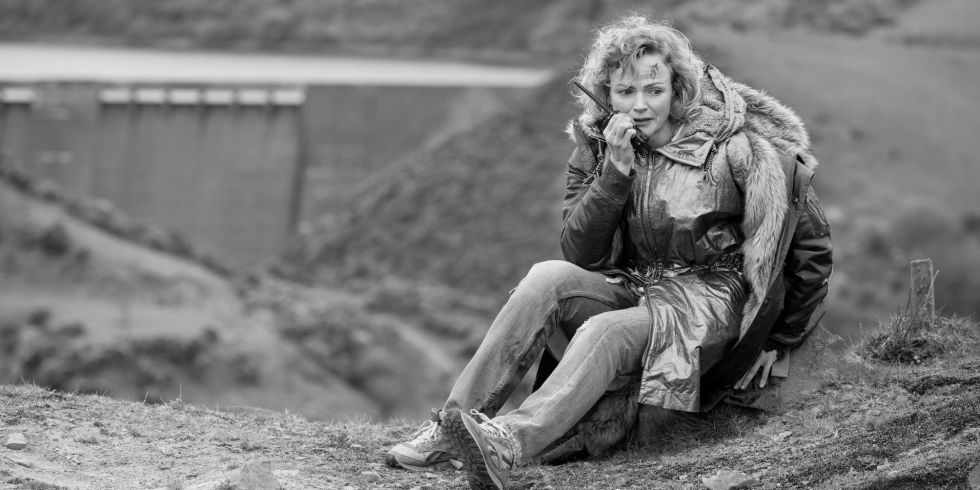
This one’s the shortest episode of this season, and appropriately minimalistic, to the point that it’s shot in black and white and can even get away with it. It’s pared-down, ultra-gritty Asmovian sci-fi that follows a desperate fight for survival between man and machine. Maxine Peake – or, as you may think of her during the episode, Maxine Bleak – turns in a stalwart performance as a human pursued by killer robots.
With her co-stars not lasting long, the only other character for the bulk of the narrative is the killer robot itself – a sleek little puppy that’s probably deliberately reminiscent of Boston Dynamics’ various ‘Big Dog’ robots, which drew their fair share of internet attention. The robot – actually called ‘dogs’ in-universe – would seem curiously adorable if it wasn’t a vicious, relentless killing machine.
Even with a fairly light touch, the episode successfully evokes a terrifying, post-apocalyptic world, all but empty of organic life – the temptation would be to compare it to something like Children of Men or 28 Days Later, but given the villain, the only comparison can be Terminator, and its vision of a future populated largely by gardens of skulls. The episode’s light on actual narrative – hence the short running time – but with more action set-pieces it could easily have been spun out into a full-length feature film.
Indeed, the lack of narrative is a strength more than anything – casting the robots as one of those creeping, inexplicable, nameless fears. The viewer is left to construct their own rationale for what’s happening, and can choose one as scary as they like. This is why the twist ending falls so flat, and brings down the rest of the episode with it – it’s a particularly ham-handed attempt at adding poignancy that reduces the whole episode to a shaggy dog story.
4. Episode 3 – Crocodile

Drawing its visuals from the recent wave of Scandi-noir crime dramas, the story of ‘Crocodile’ is actually far more Hitchcock than anything else, concerning a woman with a dark secret in her past who has it come back to haunt her, and now, with a young family, has to cover it up. At the risk of spoilers, she does this by dropping more bodies than you might expect in a story about a hitman with anger issues.
Where does the dark-tech come in to this tale of murder after murder, I hear you cry? Well, it doesn’t initially. The dark-tech this go-around is a device that can display people’s memories (again, much like ‘The Entire History of You’), which is used to solve crimes, or – as it is here – to sort out insurance claims. Trying to track down anyone who might have witnessed a man getting hit by a self-driving pizza delivery robot, Shazia follows the trail to Mia, our multi-murdering protagonist – and she did witness the accident, but it was seconds after having killed a man, so she isn’t too keen to have anyone poking through her memories.
Critics have already dismissed this one as far too bleak – which is an odd accusation to cast at Black Mirror, even if it tends to be cyberpunk bleak rather than normal bleak. And more to the point, between the Scandi-noir window dressing and the grim subject matter, it’s clear that it being unremittingly bleak was the whole point. The only issue is that round about the fourth or fifth round of Mia killing someone else to cover her tracks, it starts to feel like it was actually intended as incredibly dark comedy, and the director didn’t get the memo.
Of course, the real villain of the piece is the hotel receptionist who tells Shazia he cannot possibly divulge the identity of someone who stayed in a particular room – but cheerfully lets her know that they sampled some pay-per-view porn.
3. Episode 3 – Hang the DJ
Without a doubt the softest and lightest of this year’s crop, Hang the DJ seems to be an attempt to capture the sweetness and joy of last season’s San Junipero. And while it couldn’t possible hope to match the transhumanist joy of San Junipero, like that episode it has the benefit of presenting a pair of leads with genuinely convincing chemistry.
Set in some sort of idyllic holiday park surrounded by high walls on all sides, the dark-tech here is a system of algorithms that pair people up for pre-determined times, intended to take all their personality traits onboard and finally whittle them down to the perfect match. The carefully stage-managed, authoritarian approach to relationships presented in this world is similar to Yorgos Lanthimos’s film The Lobster, which presented a slightly crueller setup – singles are given 45 days to find a romantic partner, and in the event of failure, get turned into animals.
There is no failure condition in Hang the DJ, nor any particular risk of mutilation or transformation, which may be the scariest part of all – the idea that the algorithms will, eventually, pin you down. Interestingly, both protagonists, Frank and Amy, view the whole setup with some scepticism, and part of their bonding is over speculating what exactly’s going on here. Given that the purpose seems to be setting up attractive, able-bodied young people in (bar a rounding error) heterosexual relationships, you might easily start to think it’s part of some new-age eugenics program, and that the wall isn’t to keep them in, but rather to keep the uglies and the undesirables out.
As potentially-horrifying as the system in play is, the darkness of the episode exemplifies how Black Mirror at its most horrifying is all down to people – really, the darkest moments are less dark than they are tedious, drawing on the incredibly relatable idea of being stuck in an unpleasant relationship. When the twist comes – because there’s got to be a twist – it manages to turn the events of the episode on their head while being based firmly in what’s been established, rather than coming straight out of left field. More twists like that, please.
2. Episode 1 – ‘USS Callister’
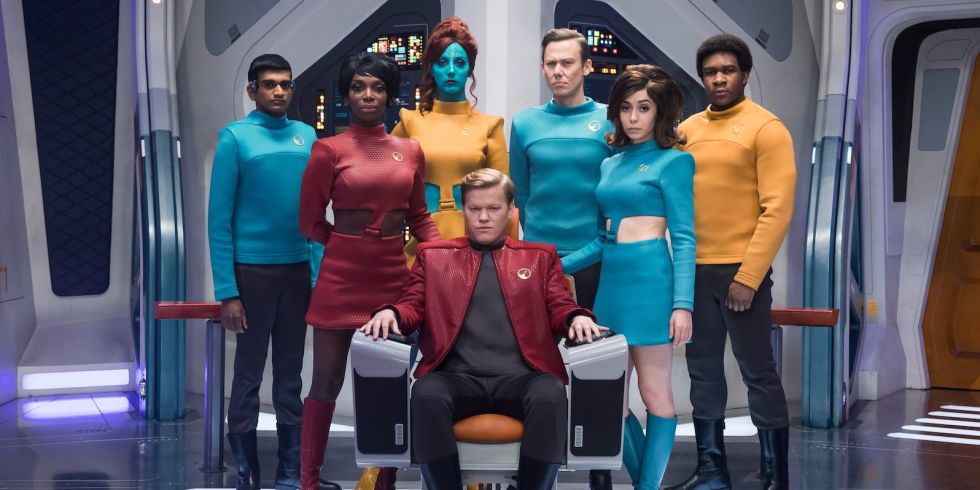
An unapologetic homage to the original series of Star Trek, USS Callister follows Robert Daly, played marvellously by Jesse ‘Meth Damon’ Plemons of Breaking Bad fame – by day he’s an under-appreciated code monkey working on Eternity, the hottest new virtual reality spacefaring game, but by night, he vicariously lives out the life of not-Captain Kirk in his homebrew Star Trek mod of the game.
This one revisits the dark-tech of the Christmas special, in which a person’s entire self can be cloned and uploaded digitally as a ‘cookie’, and you may be able to guess where this is going – Daly is taking out his workplace resentments by cloning his co-workers into the game and forcing them to go along with his Kirk-themed power fantasies. This creates the sublime dark humour of Daly giving a boilerplate moralising Starfleet speech, before turning around and torturing someone for talking back.
Daly’s true nature is revealed when Nanette, a new Eternity employee, finds herself getting uploaded as Daly’s questionable way of dealing with his apparent crush on her. While the cookies of the rest of the office staff have resigned themselves to the hellish netherworld of the Enterprise’s bridge – by drinking heavily, it seems – Nanette still has enough spark and fury to start working towards an escape plan.
There is a fairly unsubtle analogy being drawn here about the behaviour of men in positions of power, with the most common comparison being Harvey Weinstein – Daly makes the simulated women of the office line up to kiss him after each successful mission. And say what you will about Kirk, but he never did anything like that (because he was too busy salivating at the prospect of what he and Spock would do to each other later). But there’s another analogy here, about artificial intelligence’s and the way people treat characters in computer games, which would immediately become horrifying if the characters had any sort of consciousness – which, really, is just a matter of time. For example, who can forget that classic scene in Spaced where Tim launches Lara Croft off a cliff, over and over?
1. Episode 6 – ‘Black Museum’
And a massive number 1 for Black Museum which, as the name suggests, is hinting towards some meta-commentary about the show as a whole. The episode is itself an anthology, consisting of three mini-stories (which all tie together towards the end) – and, harking back to the halcyon days of The Twilight Zone, one of them is an adaptation of a short story by famously vocal magician Penn Jillette. Proceedings are all presided over by the museum’s proprietor – a cryptkeeper-like figure who’s half Barnum and Baileyesque showman, and half Satan.
Like USS Callister, this episode also revisits the idea of human consciousness being digitally copied – including the idea of a huge number of copies being kept in constant agonising pain. This flies surprisingly close to the infamous thought experiment known as ‘Roko’s basilisk’, in which a hypothetical artificial intelligence would eternally torture anyone who did not actively contribute to its creation – essentially a fire-and-brimstone hell for the techie crowd. There’s more than just nerdy existential horror, in play, though, as another of the stories involves possibly the most graphically violent scene in Black Mirror so far. The worst of it is kept off-camera, but that isn’t saying much.
This episode is almost certainly the heaviest on Easter eggs, though granted I haven’t been through freeze-framing anything that looks familiar. Of the museum’s exhibits, any that don’t get their own story are likely from one of the previous episodes, such as the lollipop from USS Callister (which sounds silly if you haven’t seen it, but is powerfully dark if you have). Possibly the most relevant, though, is the moment of prominence given to the outfit worn by the hunters from ‘White Bear’ – as this episode also involves a convicted criminal being punished disproportionate to their crimes for the amusement of a paying audience.
Like Hitchcock’s The Birds did many a year ago, this points the finger squarely at the viewer – saying in effect that it is the presence of an audience that brings about these awful things, that we as viewers are not so very different to the people who flocked to the Black Museum. I won’t say exactly what the museum’s centrepiece entails, just that – in the context of American society, and its, shall we say, special relationship with race – its name is actually a distasteful pun.
I’d have to say season 4 is pretty much on par with 3, that is to say not up to the same snuff as the first two (before those Netflix fat-cats got their paws on it, etc., etc.) – but as possibly the most renowned anthology series out there, that is an incredibly high standard to reach. Yes, there’s the occasional near-fatal flaw, but for every one of those there’s plenty of those classic Black Mirror moments – which don’t even have to be upsetting, just something that can reach out of the screen and puncture the viewer’s thickening shell of numbness. When the robots finally snap and start crawling out of our sinks to drink our blood, I’d want it to be Black Mirror dramatising it.
Some of the coverage you find on Cultured Vultures contains affiliate links, which provide us with small commissions based on purchases made from visiting our site. We cover gaming news, movie reviews, wrestling and much more.



